Editor’s note: This is the final article in a two-part series about how to monitor and, if necessary, change a herd’s reproductive management. Click here to read the first part in this two-part series. A variety of approaches and details on how to monitor and evaluate reproductive records have previously been described elsewhere. Today’s computer records programs have the ability to create many different graphs and figures. Unfortunately, many people settle for the pre-formed graphs or canned reports and try to determine what these reports are telling them. However, the population at risk is often not defined, the time at risk is not specified, or the metric reported does not necessarily reveal the true condition of the system. A better approach is to use a few general reports or graphs that describe a few important outcomes of interest as screening tools.
Then, ask more specific, appropriate questions, preferably related to the processes rather than simply the outcome, and find the data that answers the questions posed. With this approach, the operator must first think of the question (i.e., the problem) and look to find answers using specific ranges in time.
Selecting the appropriate items to record for monitoring is important; do not ask employees to collect mountains of data simply for the sake of collecting data unless there is a plan to use it. Once it is collected, use the information to provide feedback, both positive and negative, to employees.
Otherwise, with a lack of feedback, data collection deteriorates, the quality of both the records and the work declines, and the data becomes useless for monitoring.
When evaluating reproduction, there are a few key questions that should serve as the basis for investigation, with additional questions developed as the investigation continues, depending on the initial outcomes.
One potential approach towards investigating potential issues as they relate to compliance and reproductive management of TAI protocols will be detailed.
For the purposes of this paper, the DairyComp 305 records from several large dairy herds milking between 1500 and 3000 cows each will be utilized to illustrate specific examples. Each of these herds utilizes TAI to varying degrees and is located within the U.S.
When investigating reproductive performance, one of the first areas to examine is the days-to-first-insemination graph to assess the voluntary waiting period, to try and understand their approach to first service, and to assess the consistency with which cows have been presented for first service.
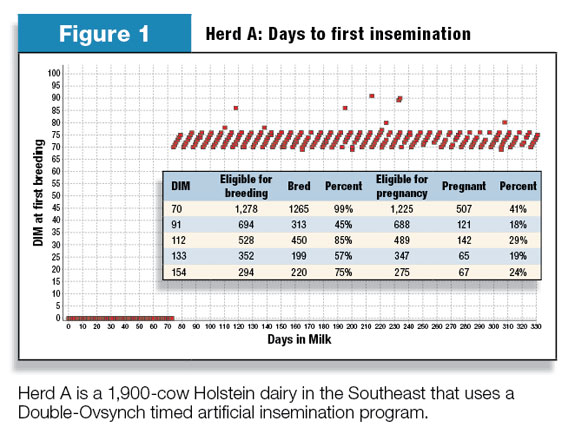
In Figure 1 , the first insemination history for one year for Herd A, a 1,900-cow Holstein dairy, is shown. Each red square represents a cow and the y-axis is the DIM at first insemination and the X-axis reflects the current DIM for cows in the herd. The red squares at lower left are cows that have not yet been inseminated.
Based upon this figure, Herd A is utilizing some form of TAI (Double-Ovsynch) with a very high level of compliance, since very few cows are inseminated outside of the 1-week range starting at the voluntary waiting period of 70 DIM for first service.
The table inset in Figure 1 is the historical reproductive performance for this herd for the first five 21-day cycles following the voluntary waiting period for one year and it shows the net impact of this high level of compliance and a high first-service conception rate (CR).
This herd is a Southeastern dairy that has adopted the use of RFID and takes great advantage of this tool, with an annual pregnancy rate (PR) of 26 percent. The advantage of this system is that there are no mis-read numbers, no missing cows (assuming all tagged animals are scanned) and a faster ability to locate animals for injections, vaccinations, examination, etc.
Based upon the computerized records, 97 percent of all cows in Herd A are inseminated for the first time between 70 and 76 DIM, with 99 percent serviced between 70 and 90 DIM, thanks in large part to the excellent compliance afforded by the RFID system.
For comparison, consider Herd B, a Southwestern dairy that utilizes a commercial reproductive management team that relies heavily on ultrasound to make individual cow-based breeding decisions. The herd is set up on a Presynch-Ovsynch program, but individual decisions are made for each cow based upon findings at each weekly ultrasound.
Instead of achieving 95 percent insemination efficiency or more within the first week of the voluntary waiting period, as is expected with a weekly TAI program, this herd breeds 43 percent within the first week. This program was implemented in an attempt to maximize CR, but suffers from compliance challenges and delays in actually delivering inseminations.
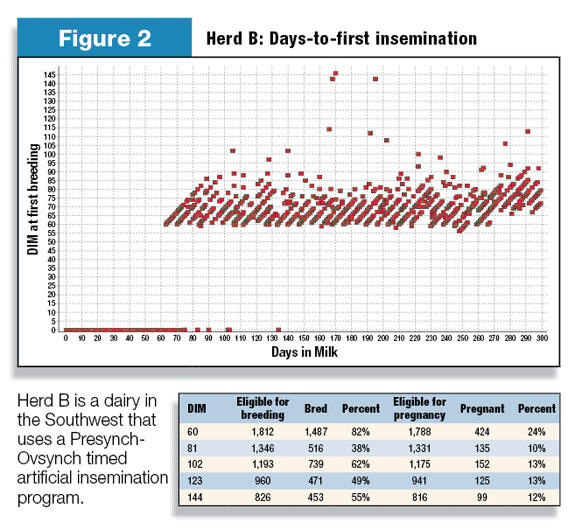
Figure 2 shows the first-insemination history for Herd B.
This herd has 10 different recorded breeding codes for first service, and despite all of the weekly ultrasound examinations and individualized decisions for guiding the inseminations, the first-service CR is only 32 percent.
The table below Figure 2 reports the annual PR results for the first few 21-day cycles of breeding.
Based upon the annual PR of 13 percent and the poor overall results within the first few cycles, it is quite clear that Herd B struggles to get cows inseminated in a timely and efficient manner. By delaying some inseminations, only 82 percent of cows are inseminated in the first 21-day cycle.
This herd’s reproductive performance suffers from its very complex breeding system and might benefit from simply placing cows onto a more regulated Presynch-Ovsynch or Double-Ovsynch program for first service instead of delaying completion of the TAI program based on ultrasound findings of the ovaries.
Another key figure that may be useful in terms of assessing overall herd compliance issues is consistency with which the herd’s management team presents cows for pregnancy evaluation. In DairyComp 305, this graph is created using the following command: “GRAPH PREG BY DSLH\W1”.
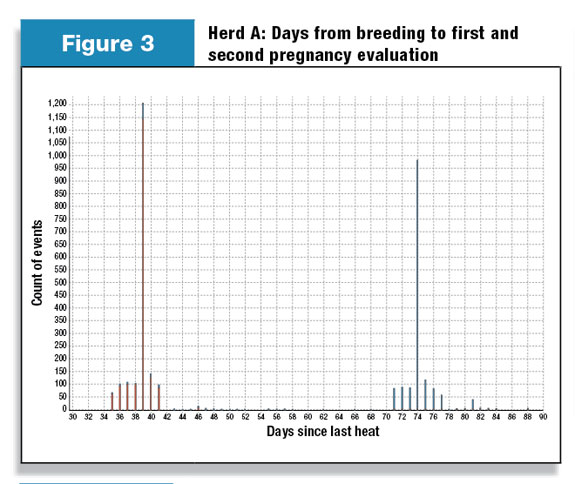
Figure 3 shows the days since last insemination for the first pregnancy determination (35 to 41 days since last insemination) and for the verify exam (71 to 77 days since last insemination) for Herd A.
The Y-axis is a count of events and the X-axis is the days between insemination and pregnancy determination for either the first-pregnancy determination or the pregnancy verification (second pregnancy examination for pregnant cows).
Not pictured here is the final pregnancy examination that occurs between 211 and 217 days of conception. Notice the scarcity of data points after each set of pregnancy examinations.
This herd conducts pregnancy evaluations once a week and the few points that appear out of the schedule are most likely cows that were flagged for rechecks due to issues detected by palpation per rectum. The highest columns correspond to cows inseminated via TAI.
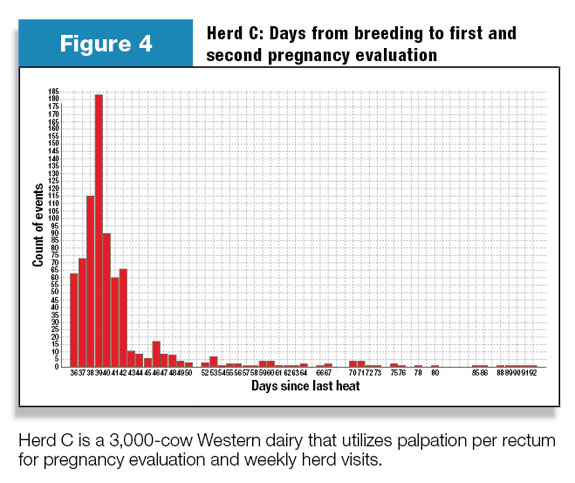
For comparison, consider Herd C’s graph shown in Figure 4 using a slightly different command string and compared to a different dairy, Herd C, which is a 3,000-cow Western dairy.
Again, the X-axis represents the number of days since insemination for the pregnancy examination and the Y-axis is a count of cows.
Herds A and C both utilize only A.I. for first service and both herds utilize a veterinarian for pregnancy determination on a weekly schedule.
The major difference between the two herds is that Herd A uses RFID to find all cows on the list and will seek out cows that are missing, while Herd C uses a paper list and has the philosophy of “well, we’ll get her next time” if she is not found during the herd check.
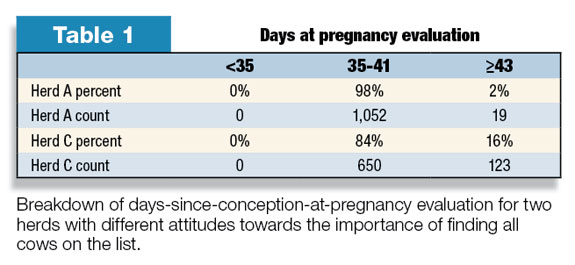
To better compare the two herds, consider Table 1 , which contains a breakdown of the days-since-conception-at-pregnancy evaluation for each herd.
Herd C has approximately 10 times greater odds of having cows experience a delayed pregnancy evaluation as compared to Herd A. If all cows were pregnant at examination, there would be no issue; but when cows are skipped and later found to be non-pregnant, the herd has experienced an economic loss via a lost opportunity to intervene with a strategy to deliver the next insemination.
Also, an attitude such as the one shown by Herd C is likely to carry over into the administration of injections for TAI protocols, delivery of vaccinations, movement of cows, etc. Depending on where the cow is in her injection schedule, a single missed injection could be the difference between a pregnancy and another 40 or more days open, as well as the wasted injections.
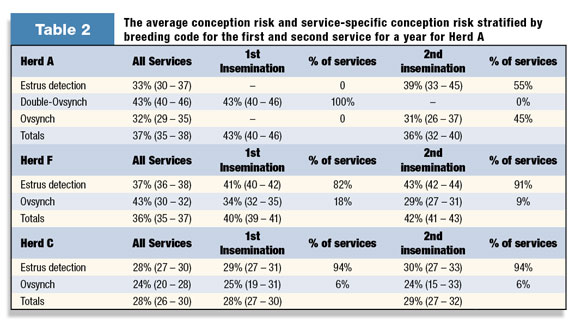
Another area that should be examined when investigating reproductive performance, and TAI specifically, are the results of the inseminations, including the CR by breeding code and whether or not the results match the intent of the reproductive program. (See Table 2 .)
For example, Herd A’s goal is to breed all cows for the first time using the Double-Ovsynch protocol. After first service, cows are examined daily for estrus and bred accordingly.
If not observed in estrus within 28-34 days, cows receive a GnRH injection as part of the resynchronization protocol. Pregnancy examination occurs at 35-41 days since previous service and non-pregnant cows then receive a prostaglandin injection and complete the Ovsynch protocol with the next service occurring at 45-51 days since the previous service.
In this herd, 100 percent of the first inseminations are via Double-Ovsynch and 55 percent of the second services are via estrus detection, with the remainder occurring via Ovsynch.
Based upon the authors’ clinical experiences, the CR for each of these services is above average for herds in the Southeast. One concern that some may express is that only 55 percent of the second services were performed via estrus detection.
However, considering the resynchronization approach used in this herd, cows have only one opportunity to recycle with a normal return to estrus prior to starting the Ovsynch program for the second service. In addition, there is a conscious decision to not inseminate cows that display marginal signs of estrus and instead, allow them to pass through to the Ovsynch program.
As a result, both of the second-service approaches yield very acceptable levels of CR and yet, are performed in a timely manner.
In comparison, consider the CR results for Herds F and C that are shown in Table 2 above. These two herds are Western herds that utilize a Presynch-Ovsynch program with TAI occurring by 80 DIM, but inseminators are strongly encouraged to breed cows following the prostaglandin injection prior to starting Ovsynch.
However, the results are quite different between these two herds. Herd F does a very good job aggressively identifying cows in estrus and does not appear to experience significant issues with anovular cows based upon the very acceptable first service CR with both breeding approaches.
Herd C, however, suffers from cyclicity challenges, uterine health issues, estrus detection accuracy problems, and an inseminator that feels threatened by the TAI protocol. This inseminator begins breeding as early as 40 DIM and manages to inseminate 94 percent of the cows via estrus detection for both the first- and second-service opportunities.
A word of caution is warranted here; the estrus detection efficiency is only about 60 percent for each cycle, but since there are almost two full cycles at risk for estrus detection prior to the TAI, a high proportion of cows never make it to the TAI. Normally, this would be a good thing, but in this case it is not.
In Herd C, the inseminator breeds a lot of cows showing marginal signs of estrus. If the breeder applied a little more scrutiny to each cow and inseminated fewer animals via estrus detection, chances are good that the CR to both estrus detection and TAI would improve and the overall PR would increase.
Space does not allow the full explanation of how to completely evaluate CR, but in addition to examining it by service number, breeding code, and interval length since previous service, CR should be evaluated by parity, technician, day-of-the-week, month, and by combinations of these factors.
However, with each additional strata, the sample size gets smaller and our ability to accurately interpret binomial outcomes such as CR decreases.
In Herd F that was mentioned in Table 2, the reason that the confidence intervals around the CRs were so small was because there were approximately 50,000 total inseminations in this individual herd in one calendar year. Most herds do not have enough cows to achieve this much statistical power and extreme caution should be practiced when evaluating reproductive results.
Another potentially helpful tool within the computerized records for evaluating breeding management, compliance, and cyclicity status is to examine the interval between first and second inseminations while controlling for the first-service breeding code. The normal expected interestrus interval for dairy cattle is 18 to 24 days.
However, many factors can impact the actual interval to next service including accuracy of estrus detection, technique used for first service (TAI or estrus detection), cyclicity status immediately prior to first service, compliance to TAI protocols, stage of the cycle when starting TAI, and pregnancy wastage (early or late embryonic death or abortion).
If cows are incorrectly identified as in estrus and inseminated, the return to next service should be less than or equal to 18 to 24 days, depending upon when in her cycle she was first inseminated. If early embryonic loss occurs (a loss of a pregnancy prior to approximately d-17 of the cycle), a normal return is expected.
However, if late embryonic death occurs (loss of a pregnancy after d-17 but before d-42), the return to estrus is expected to be lengthened and the actual return depends on when the loss occurs and the status of follicular development at the time of the loss.
When TAI is involved in the first service, a variety of unusual intervals are possible, depending upon whether or not a presynchronization series was used, whether all injections were given as required, and whether the cow was cycling or not prior to starting TAI.
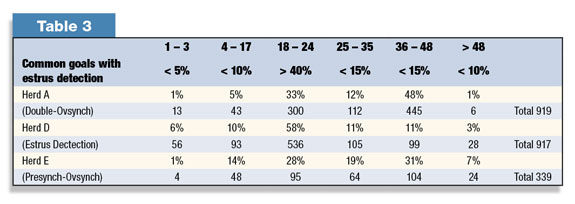
For example, consider Table 3 , a breakdown of the interestrus intervals between first and second inseminations for three herds utilizing different approaches to delivering first insemination.
At the top of the table are some commonly used goals for herds relying on estrus detection, but these goals are not applicable to herds relying heavily on TAI.
Herd A utilizes a Double-Ovsynch program for all first services; Herd D uses estrus detection and prides itself on very high estrus detection efficiency; Herd E uses the Presynch-Ovsynch protocol to synchronize cows for first service, but inseminates any cow observed in estrus following the second injection of prostaglandin within the presynchronization series and then delivers a TAI insemination to those cows not previously inseminated.
Herds utilizing TAI have a different set of expectations for the intervals from first to second service as compared to herds relying on estrus detection.
For TAI herds utilizing some form of presynchronization prior to Ovsynch and with a low prevalence of anovulatory animals at the start, there should be less than 1 percent of cows in the d-1 to d-3 category, since any cow that would express estrus within three days of a TAI should have had a follicle capable of responding to the final GnRH if the injection was properly given.
The only cows that are expected to actually re-cycle within this time period would be cows started on Ovsynch on d-3 or 4 after ovulation (Paul Fricke, personal communication).
However, in herds that do not presynchronize prior to TAI, assuming that cows are randomly distributed throughout a typical cycle, about 9 percent of the cows would start Ovsynch on d-3 or 4 after estrus and therefore, on average about 9 percent would be expected to have first to second service intervals of 1-3 d.
These cows fail to respond to the first GnRH injection, but do respond to the prostaglandin injection seven days later; these animals are likely to have a new follicular wave starting that is not yet capable of responding to the final GnRH injection. Consequently, the cow expresses estrus two to three days after the TAI.
Several factors related to TAI will alter the proportion of cows appearing to have first-to-second service intervals of 4 to 17 d. First, when cows are still anovulatory at the start of the Ovsynch protocol, some will ovulate for the first time in response to the final GnRH injection.
Since this is the first time that her body has experienced a rise in progesterone since parturition, she is likely to experience a shortened luteal phase followed by spontaneous luteolysis and may express estrus anytime from d-8 to d-12 following the first TAI.
Careful evaluation of the first-to-second service interval can thus be used to suggest that cyclicity issues may be a problem in herds relying heavily on TAI for first service.
Second, cows that start Ovsynch in the second half of the estrous cycle that fail to ovulate to the first GnRH will come into estrus during the protocol, usually around the time of the prostaglandin injection. If these cows are not serviced at this time based on the expression of estrus, they will appear to have a shortened interestrus interval of 14 to 17 d, but in fact, have actually had a normal cycle (25).
If cyclicity and presynchronization are not problematic, there should be less than 5 percent of cycles falling in the d-4 to d-17 first-to-second service interval. If this number rises, more scrutiny into the actual distribution within this category is required to determine the potential cause.
Aside from using secondary indicators of cyclicity and compliance such as the herd breeding records, perhaps a better, albeit more expensive approach would be to sample a number of cows twice to measure progesterone levels via serial sampling approaches or to perform an ultrasound examination (5, 11, 12, 26).
With ultrasound, if cows have been presynchronized, examinations can be performed at the time of the first GnRH injection since cycling, presynchronized cows should have a functional, measurable CL at this time.
Using progesterone testing, samples can be taken at the time of the final prostaglandin of presynchronization and again 10 to 14 d later when GnRH is first administered. If blood progesterone levels at one or both of the sampling times is greater than 1.0 ng/ml, the cow is classified as cycling.
If the objective is to measure TAI synchronization efficiency, a slightly different approach is taken. For this purpose, a blood sample is taken from 20 to 25 cows on the day of TAI and again from the same cows 7 to 10 days later. If the cow was cycling and the prostaglandin injection was given appropriately, the progesterone level at the time of TAI should be less than 1.0 ng/ml.
In 7 to 10 days, progesterone should be elevated above 1.0 ng/ml. If both samples have progesterone levels below 1 ng/ml, the cow is not cycling. Notice that this approach is called synchronization efficiency and not synchronization compliance.
Without multiple repeated samples from the same cow, there is no way to truly assess compliance for each injection. However, if progesterone is high at the time of TAI, cows will not become pregnant and there was obviously a failure of cow identification or failure of appropriate administration of an adequate dose of prostaglandin. A generally cited goal for this measure of efficiency is 90 to 95 percent.
Summary
One of the tools successful managers have used to improve reproductive performance in their dairy herds has been TAI. A wide variety of protocols exists, but each one is designed to synchronize ovulation in order to afford an acceptable CR via appointment breeding.
One of the clear differences between herds that have been successful with TAI and those that have failed has been the attention paid to compliance to the protocol. When utilizing TAI, careful selection of the appropriate protocol, followed by consistent implementation and routine monitoring of both the processes and the ultimate outcomes, are all key components for success. PD
References omitted due to space but are available upon request to editor@progressivedairy.com .
—Adapted from 2011 Society for Theriogenology Conference proceedings
Overton is a professor at the University of Georgia’s College of Veterinary Medicine . Heins is a veterinarian completing a master’s degree in food animal medicine at the same institution .

Michael W. Overton
Professor of Veterinary Medicine
University of Georgia
moverton@uga.edu





